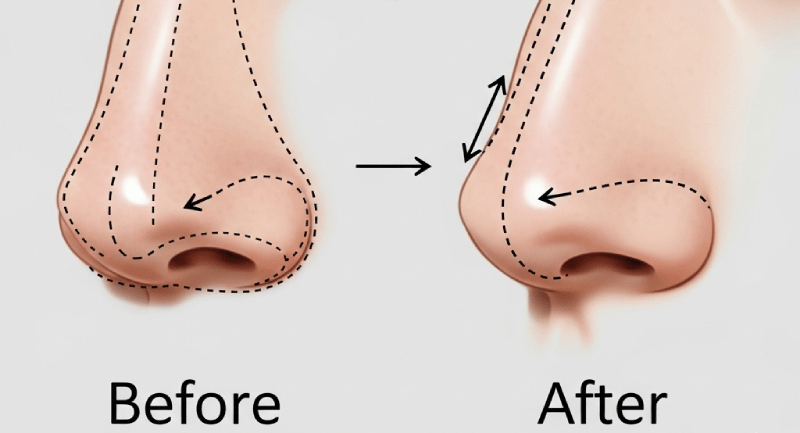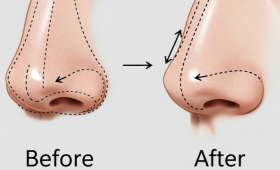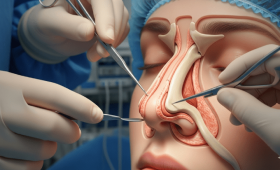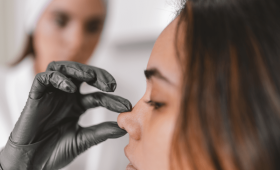Turkey has emerged as a global hub for rhinoplasty. The key factors behind this rise are the widespread use of advanced surgical techniques and modern technologies, highly competent surgeons with international certification, and cost-effectiveness. Rhinoplasty has become a key driver of Turkey’s medical tourism sector, catering to the growing demand for aesthetic and dental procedures typically not covered by insurance. This report provides an in-depth analysis of the dynamics of the Turkish rhinoplasty market, surgical procedures, patient experience, cost structures, and professional standards. The analysis indicates that the market competes not only on cost but also on a high level of surgical skill, technological innovation (such as Piezo), and meticulous patient management. While pricing varies based on the surgeon’s experience, the technique used, and geographic location, it remains highly competitive compared to the international market. A key finding of the report is the holistic approach taken to meet both the aesthetic and functional needs of patients, emphasizing the critical importance of selecting a qualified physician with professional certifications.
Section I: An Overview of Rhinoplasty in Turkey
The rapid growth of Turkey’s health tourism sector is particularly pronounced in plastic surgery and rhinoplasty. Rinoplasti, both aesthetic and functional goals are included in a popular surgical procedure. Aesthetic concerns include correcting a dorsal hump, lifting or refining the nasal tip, shaping the nostrils, and adjusting the nasal angle. Functional goals typically involve correcting a deviated septum to resolve breathing problems.
The driving force of this surgical branch in Turkey’s health tourism is directly linked to global market dynamics. In developed countries, aesthetic surgeries are generally not covered by health insurance, which prompts patients to seek more affordable, high-quality services. Turkey possesses a competent medical infrastructure and a large pool of experienced surgeons to meet this demand. This elevates rhinoplasty from a singular medical service to a key offering that defines Turkey’s strategic position in the international health market. This process demonstrates not only a cost-based competitive edge but also operational excellence and innovative approaches.
Section II: Surgical Techniques and Technological Advancements
Rhinoplasty operations in Turkey utilize a wide range of surgical techniques, from traditional methods to the latest technological approaches. This variety provides surgeons with the flexibility to choose the most suitable method for the patient’s specific needs.
Traditional and Advanced Surgical Techniques
Closed Rhinoplasty: In this technique, all incisions are made inside the nostrils, leaving no external scars. Since less damage is done to the blood vessels and nerves at the nasal tip, the risk of post-operative numbness is minimal. While the surgeon’s working area is more limited, the closed technique can result in a faster recovery and less swelling and bruising.
Open Rhinoplasty: This method is performed with a small 3-4 mm incision at the base of the nasal tip (columella region). This incision allows the nasal tip to be lifted, providing the surgeon with a wider and more direct view of the nasal cartilage and bone structures, as well as greater maneuverability. The open technique is particularly preferred for revision surgeries or when more extensive changes to the nose are required.
In addition to these fundamental techniques, some surgeons have developed their own unique methods. For example, hybrid approaches known as the “delivery method” and the “modified delivery method” aim to combine the scar-free advantage of the closed technique with the broad field of view of the open technique. The existence of such innovative and specialized methods indicates that the Turkish rhinoplasty market is not only mature in performing standard procedures but also in surgical skill and artistry. Surgeons are continuously improving operational processes by going beyond standard approaches.
Piezo (Ultrasonic) Rhinoplasty Technology
Piezo rhinoplasty is one of the most significant technological advancements in the field of nose aesthetics. This method uses ultrasonic sound waves generated by piezoelectric devices instead of traditional bone-breaking instruments. These devices allow for the precise shaping of bone and cartilage without damaging soft tissues, vessels, and nerves.
The main advantages of Piezo technology compared to traditional methods are less bleeding, less swelling and bruising, and therefore a faster recovery process. This technology also helps achieve more natural and aesthetically pleasing results by making more controlled and precise incisions. The duration of a Piezo surgery can vary between 1 and 3 hours depending on the complexity of the nasal structure. Patients can often be discharged the same day, and their recovery time is shortened. This is a major draw for medical tourists with limited time. The widespread adoption of Piezo technology strengthens the “more comfortable” and “faster recovery” promises of clinics in Turkey, which directly increases market competitiveness. This technological investment enhances patient satisfaction and reinforces Turkey’s expertise and leadership in rhinoplasty.
| Evaluation Criterion | Open Rhinoplasty | Closed Rhinoplasty | Piezo Rhinoplasty |
| Incision Type | External incision at the nasal tip | Incision inside the nostrils | Incision inside or below the nostrils |
| Field of View | Wide and direct | Limited and internal | Wide and direct (with Piezo device) |
| Recovery Time | 7-10 days | Faster | Shorter than traditional methods |
| Swelling and Bruising | Can be more pronounced | Less | Minimal |
| Precision | Limited by traditional instruments | High (requires experienced surgeon) | Highest precision with ultrasonic sound waves |
| Suitable For | Revision and complex procedures | Limited corrections | Most cases, especially for delicate bone shaping |
| Scarring | A 3-4 mm scar may remain on the nasal tip | No visible external scar | No visible external scar |
Section III: Pre-operative and Post-operative Management
The success of a rhinoplasty operation is not limited to the surgeon’s skill; meticulous management of the pre-operative preparation and post-operative recovery period is also crucial.
Pre-operative Preparation
The pre-operative process begins with a detailed examination and personalized planning. The surgeon evaluates the patient’s facial features, nasal bone and cartilage structure, skin thickness, and elasticity. The patient’s expectations are discussed, and their compatibility with facial symmetry is examined using simulation techniques.
Medical tests are also an integral part of this process. Blood tests, EKG, and allergy tests for anesthesia are performed to assess the patient’s general health and suitability for anesthesia. These tests are vital for increasing the safety of the operation and minimizing potential risks.
Furthermore, patients are expected to adhere to lifestyle adjustments before the surgery. Smoking and alcohol consumption, which can negatively affect wound healing and increase the risk of infection, should be stopped at least two weeks before the surgery. Blood-thinning medications like aspirin and certain herbal supplements, which can increase the risk of bleeding, must be discontinued at least one week before the operation. On the day of the surgery, patients are required to fast for at least 6-8 hours to prevent stomach contents from entering the lungs during anesthesia. Strict adherence to these instructions directly impacts the safe progression of the surgery.
Stages of the Recovery Period
The recovery process can vary from patient to patient and depending on the technique used, but it generally consists of specific stages. Patients are typically kept under observation in the hospital for the first 24 hours after surgery. During this period, keeping the head elevated and applying ice helps reduce swelling and bruising.
Within one week, the cast and internal nasal splints are removed. If there are external stitches, they are also removed at this stage. While swelling and bruising on the face and around the eyes are prominent during this first week, they begin to decrease rapidly from the second week onwards. By the end of the first month, 80-90% of the swelling subsides, and patients can return to non-strenuous daily activities. Methods such as “comfortable rhinoplasty,” which do not use nasal packing, can increase patient comfort and speed up the recovery process.
However, the nose undergoes a long process that requires patience to take its final shape. It can take 6 months to 1 year for the remaining swelling to completely disappear and for the nose to reach its final form. This process may be even longer for individuals with thick skin. During the recovery period, it is crucial to follow rules such as protecting the nose from impact, avoiding heavy exercise, not wearing glasses, and staying out of the sun. Strict adherence to these instructions minimizes the risk of complications and directly contributes to a successful surgical outcome.
Potential Risks and Complications
As with any surgical procedure, rhinoplasty carries certain risks. General surgical risks include infection, bleeding, and reactions to anesthesia. Risks specific to rhinoplasty include post-operative breathing difficulties, numbness in the nasal tip, or aesthetically unsatisfactory results. In rare cases, more serious complications such as a hole in the nasal septum or skin necrosis can also occur. Most of these risks can be minimized by the surgeon’s experience and the patient’s compliance with pre- and post-operative instructions.
| Pre-operative | Post-operative | |
| Preparation/Care | Lifestyle Adjustments: Stop smoking and alcohol (2 weeks prior), discontinue blood-thinning medications (7-10 days prior). | Post-operative Care: Sleep with head elevated for the first 3 days and apply ice. Remove splints and dressings in the first week. Avoid sun exposure (2 months). |
| Nutrition | Stop eating and drinking 8 hours before surgery. Consume protein and whole grains before the operation. | Start with light, liquid foods. Avoid hard, difficult-to-chew foods (1 week). Drink plenty of water. |
| Glasses/Clothing | Stop wearing glasses at least 1 week before surgery. Prefer button-down shirts. | Avoid wearing glasses (at least 2 months). |
| Activity Restrictions | Share medication and allergy history with the doctor. Arrange for a companion. | Sports: Avoid strenuous exercise for the first 15 days, return to normal sports after 3 weeks, and contact sports after 5 weeks. Swimming and individual sports can be resumed after 15 days. |
| Additional Information | Do not wear makeup or nail polish, and remove jewelry on the day of the surgery. | Pain and Bruising: Pain is usually mild and can be managed with medication. Bruising resolves on its own within 2 weeks. |
Section IV: Cost Analysis and Pricing Factors
Rhinoplasty prices in Turkey vary widely depending on many factors, including the surgeon’s experience, the complexity of the operation, the technique used, and the geographic location. This broad price range reflects the different segments and service levels of the market.
Pricing Structure
Prices are often offered in “packages” that may include routine pre-operative tests, hospital fees, anesthesia, and the surgeon’s fee. However, the contents of these packages are not the same at every institution. Some institutions include post-operative hospital stay in the price, while others may charge an additional fee. Therefore, it is important to clearly discuss what is included in the package and the cost of additional services like revision surgery before the operation.
The type of operation also directly affects the cost. The average price for a first-time rhinoplasty in 2025 can range from 1,600 to 4,500 Euros. More minor procedures like a nose tip plasty (tip plasty) range from an average of 1,500 to 3,000 Euros, while prices for more localized procedures like nostril reduction (alarplasty) can start from 1,000 Euros. Revision rhinoplasty surgeries are usually more expensive due to being more complex and longer than the initial operation. However, in some cases, the surgeon who performed the initial surgery may not charge an additional surgical fee for a revision, in which case only the hospital and lab test costs are paid.
Regional and Institutional Price Differences
Prices also show significant variations by geographical location. The higher cost of living and competition in Istanbul can lead to rhinoplasty prices there being an average of 20% to 80% higher than in other cities. Surgeons in Istanbul often have international recognition and therefore command higher prices. In contrast, other major cities like Ankara and Izmir and smaller Anatolian cities offer more affordable options. For example, the price for a first-time nose surgery outside Istanbul can range from an average of 1,600 to 4,500 Euros, while revision surgeries can range from 3,000 to 7,000 Euros. These price differences show that the Turkish rhinoplasty market has a layered structure that offers various options for patients with different budgets and expectations.
| Surgery Type | Price Range (2025 Euro) |
| First-time Rhinoplasty | 1,600 – 4,500 Euro |
| Revision Rhinoplasty | 3,000 – 7,000 Euro |
| Nose Tip Plasty | 1,500 – 3,000 Euro |
| Alarplasty | 1,000 – 2,500 Euro |
| Septoplasty (Deviation) | 1,300 Euro (average) |
Insurance Coverage
When performed for aesthetic purposes, rhinoplasty surgeries are not covered by either the Social Security Institution (SGK) or private health insurance. However, in cases of medical necessity, such as deformities resulting from an accident or congenital breathing problems, SGK and private insurance can cover the surgery costs. For example, procedures for functional issues, like correcting a deviated septum (septoplasty) or nasal turbinate hypertrophy, performed alongside an aesthetic rhinoplasty, may be covered by insurance. This situation can significantly change the portion of the cost borne by the patient depending on the scope and purpose of the surgical operation.
Section V: Choosing a Specialist and Professional Qualifications
Rhinoplasty is a complex operation that combines surgical skill with an artistic vision. Therefore, the most critical factor determining the outcome of the surgery is the competence of the surgeon performing the operation.
Professional Certifications and Institutional Competence
One of the most reliable indicators for evaluating a surgeon’s competence in Turkey and on the international stage is their professional certification. The proficiency certificate issued by the Turkish Society of Plastic Reconstructive and Aesthetic Surgeons (TPRECD) is an important national certificate that demonstrates a physician’s expertise in this field. This certificate is obtained by doctors who have completed a rigorous 4-year residency training and successfully passed both theoretical and practical exams. Furthermore, this certificate must be renewed every 10 years, ensuring the physician’s continuous professional development and up-to-date knowledge.
On the international level, global board certifications, such as those from the European Board of Plastic Reconstructive and Aesthetic Surgery (EBOPRAS), are a sign of a surgeon’s competence being recognized at a global level. For instance, Prof. Dr. Gürkan Kayabaşoğlu is the first Turkish surgeon to be selected and accepted as a member of EBOPRAS. The EBOPRAS exams consist of two stages, both written and oral, and are extremely challenging. Such certifications demonstrate that a surgeon’s knowledge and skills are independently validated at the highest level. For international patients in particular, these certifications serve as a fundamental criterion for assessing a surgeon’s reliability and quality.
Evaluating Case Studies and Patient Testimonials
Another way to assess a surgeon’s success is to examine before-and-after case studies. However, it is important to evaluate these photos and videos correctly. For an objective analysis, the photos should be taken using biometric photography techniques, under the same lighting and in the same setting. Selfies can be misleading due to perspective errors from the camera used. It must be ensured that the case studies demonstrate not only an aesthetic improvement but also a functional one, such as better breathing.
Patient testimonials and stories can provide valuable information about a surgeon’s approach and the patient experience. The satisfaction of patients with a reliable surgeon is often linked not just to aesthetic results but also to minimal post-operative pain and bruising, and natural-looking outcomes. A surgeon’s communication skills, attentiveness, and the professionalism of their team are also frequently highlighted in patient reviews. However, it should be remembered that these comments are subjective experiences and are not a sufficient sole criterion for evaluation.
Section VI: Conclusion and Comprehensive Recommendations
Turkey has become a global leader in rhinoplasty not just through cost-effectiveness but by combining highly competent surgeons with international standards, innovative surgical techniques, and a patient-centered approach. This is the result of a strategic positioning in the health tourism market based on trust and quality.
Recommendations for Prospective Patients
The most important recommendations for patients considering rhinoplasty are:
- Surgeon Selection: Focus on the surgeon’s experience, specialization, and national and international certifications rather than just the price.
- Comprehensive Evaluation: Ensure a holistic plan is made before the surgery that is suitable for your facial features and personal expectations, both functionally and aesthetically.
- Contract and Package Details: Clearly understand all details of the pricing package (hospital stay, revision costs, medications, etc.).
- Compliance with Instructions: Strictly adhere to critical instructions before the surgery, such as quitting smoking, alcohol, and blood thinners.
- Realistic Expectations: Remember that the recovery process is a long journey that requires patience, and it can take up to a year for the nose to take its final shape.
Strategic Recommendations for Stakeholders
To maintain Turkey’s leadership in the rhinoplasty market, strategic recommendations for stakeholders include:
- Technological Investments: Investing in advanced technologies like Piezo will further enhance patient comfort and outcome quality, strengthening market competitiveness.
- Transparent Communication: Providing full transparency in pricing policies and package contents will build trust with international patients.
- Sertifikasyon and Training: Promoting professional certification programs like TPRECD and EBOPRAS will enhance surgeons’ competence and reinforce Turkey’s image as a “reliable and competent” destination.
- Etik Evaluation: Adhering to ethical standards in the presentation of case studies and testimonials and avoiding misleading materials will contribute to the overall reliability of the sector.
This report provides a roadmap outlining Turkey’s potential in the field of rhinoplasty and how this potential can be maximized. Turkey is progressing towards becoming a global reference point for surgical excellence, technological innovation, and patient safety, transcending its position as merely a cost-advantage destination.
Discover Your Best Self: Premier Cosmetic Treatments in Turkey
Turkey has become a global leader in medical tourism, offering world-class cosmetic treatments at a fraction of the cost found in Europe and North America. This success is built on a foundation of exceptional quality, state-of-the-art facilities, and a unique blend of medical excellence and an unforgettable holiday experience.
Unmatched Value: Quality and Affordability
We believe that achieving your aesthetic goals should not come with a high price tag. Turkey’s cosmetic surgery sector, particularly for rhinoplasty, stands out for its unmatched value. Our certified surgeons are leaders in their fields, using the latest techniques like Piezo Rhinoplasty to ensure precise, natural-looking results with faster recovery.
From comprehensive rhinoplasty and revision surgeries to advanced dental and hair transplant procedures, we provide a full spectrum of cosmetic solutions. Our all-inclusive packages are designed for your comfort and peace of mind, covering everything from hospital stays and anesthesia to pre-operative consultations and post-operative care.
Your Journey to Confidence Starts with Us
Your transformation is a journey, and we are dedicated to guiding you every step of the way. From your first consultation to your final check-up, our committed team ensures a smooth, transparent, and satisfying experience.
Ready to start your journey? Contact us today to learn more about our services and schedule your free consultation.
CURE HOLIDAY…



